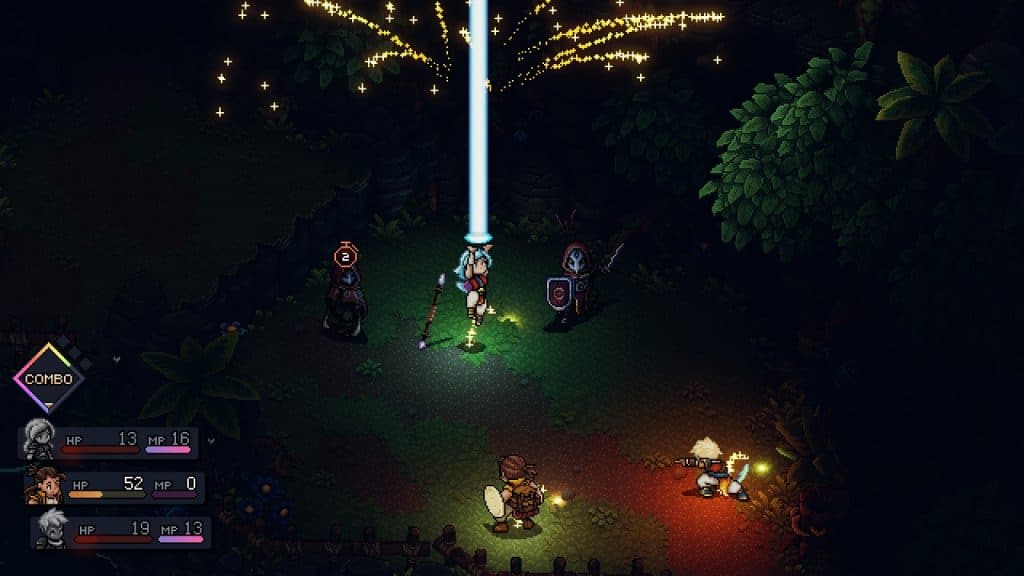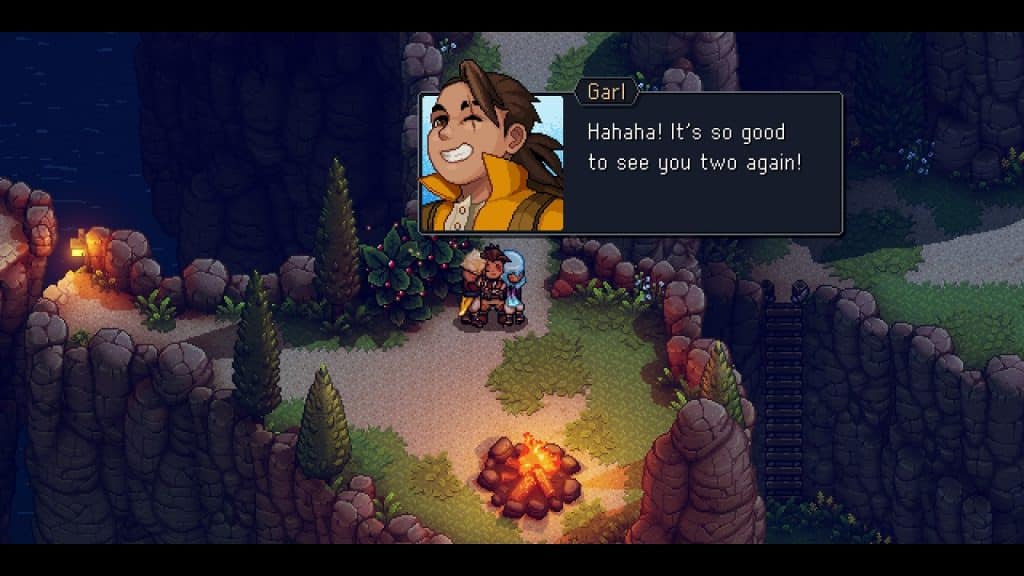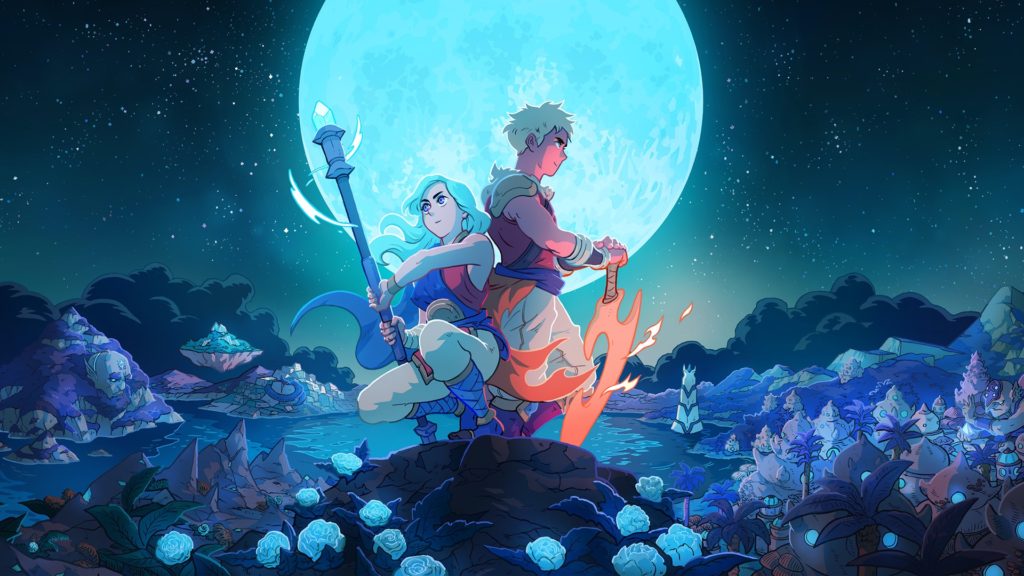Prophecies are a significant part of old-school role-playing games. One of the earliest examples I can think of is the Warriors of Light from the first Final Fantasy game. It has since become a recurring theme in many titles from the 8-bit era onwards. Sea of Stars, however, didn’t have one big prophecy. It had several smaller ones that all needed to happen lest Evil prevails.
Sea of Stars is an RPG reminiscent of the 16-bit era. Though it’s closer to that era only in terms of visuals and aesthetics, nothing more. The rest of the game is more in line with modern gaming standards including difficulty sliders and the removal of random enemy encounters. But make no mistake, is in the writing where the game shines brightest.
The story centers around the iron-clad friendship of three extraordinary individuals – Zale, Valere, and Garl. In their childhood, the three friends dreamed of a life of adventure and ridding the world of evil wherever it lured. Reality set in when Garl was seriously hurt on a fateful misadventure. 10 years later, the duo of Solstice Warriors are reunited with their best friend and they quickly get back to fully realizing childhood dreams.
The next paragraph includes some general descriptions of the allies the team picks up along the way. Consider this your spoiler warning. Go past this part if you want to know more about my thoughts on the rest of the game.
The team is first joined by the mysterious assassin, Serai. We won’t know much about her story until late in the game but it’s safe to say that she’s endured more than most will ever know. Next is Resh’an, the alchemist. Equal parts helpful and unhelpful, he would prefer that the kids figure it all out without him pulling the strings. And finally, there’s B’st who possesses a will so strong that glass might as well be steel. (You’ll know it when you know it.) Of course, there are other characters like the traveling historian Teaks and the pirate band. But that about rounds up all the playable characters in the game.
Sea of Stars is one of those games where the lead character runs in front and the two other characters follow. While inside a dungeon or a town, you have fluid control in all 8 directions. Climbing and breaking through floors is a significant part of the gameplay. Almost all dungeons have these two mechanics in some form or another. But how they are used to progress is what keeps the whole thing engaging.
The Overworld allows for movement in four directions. Eventually, you’ll get better means of transportation. Like a lot better. To the point where you’ll ask yourself, “What is even the point of walking anymore?”.
Solving puzzles usually involves pushing blocks into the right position using the Minstral Bracelet and/or using the Graplou (aka rope dart) to reach faraway objects. From my experience, these puzzles are uncomplicated but they make me feel clever after solving them. This is especially true for the Solstice Shrines.
The rest of the puzzles in the game rely on sunlight in some form or another. Whether it’s using mirrors to aim a focused beam or using your Solstice powers to manipulate the time of day, The execution is done quite well here. But man, imagine getting ready for bed and it’s suddenly mid-day. If that doesn’t mess up your sleep schedule, I don’t know what will.
Combat is centered around potentially breaking “locks” to disrupt enemy attacks by matching attack types. You will spend a good amount of time trying to figure out which combinations of attacks will cause the most disruption. RNG is a factor as there are some combinations that are just unbreakable at that point in the battle. When that happens, the only thing you can do is time your blocks to minimize the damage. It is also a good thing that the game doesn’t care about who goes first. You can swap out allies and do three separate actions before turning it over to the enemy side. Again, as a constant theme in this review, it is uncomplicated and satisfying.
What I really like about the boss battles is the fact that a good number of them have an additional puzzle-solving element. There was this one memorable battle where I had to hold out until the boss decided to purge their armor. And there is another one that really felt like I was infiltrating a base in Contra. (You’ll see what I mean when you get there.)
The game has an entire library of lively chiptune music along with some instrumentals thrown in for good measure. The battle music’s energetic tunes never fail to get hyped up for the upcoming encounter.
There is no lack of variety when it comes to all the locations you will be visiting in Sea of Stars. At one point, I was contemplating when the inevitable desert biome was going to come into play. I was mildly surprised when I didn’t see one right away. Fast forward 20 hours later, and I find myself ankle-deep in sand and following a drone to escape the vast expanse. And somehow, I was not disappointed.
The 16-bit graphics look distinctly Indie despite the high production value. I do have to point out that the animated versions look slightly different from their in-game portraits. But that’s like telling the difference between a hood and a bonnet. Actually, it adds a little more flair to every character featured. What really surprised me was the “Sea of Stars” clip near the end. That one suddenly reminded me of Star Ocean: Till the End of Time.
There’s not much in the way of bugs and glitches in the game. I had an awkward moment when a battle didn’t start for a good 15 seconds. Nothing was moving. I thought the game broke. It took a while but everyone got into place eventually. There is also the matter of sliding assets when entering cutscenes. I believe a post-launch patch addressed some of the issues but not all of them. My biggest issue with the game is that sprites clip behind background objects. It really messes up your timing for the Moonerang and the poised knife.
And speaking of the poised knife. I still don’t know what the venom and arcane elements are supposed to help with. I know that Solar does more damage to physical enemies and Lunar hurts ghost types more. But I thought venom delays attacks or something. But that’s more do with Serai’s move than the element itself. I must be overthinking it. Maybe it really is just the element needed to break some attacks. Though I’d wish they were more clear on that front.
I’ve had a pretty good time with regard to the optional content. Fishing has been toned down since the demo. Solstice Shrine puzzles are a joy to solve. My only source of frustration comes from the Wheels minigame and the Arena. RNG is no laughing matter in those two activities. I can make all the right moves and yet still lose cause a spin wasn’t in my favor or enemies suddenly have all their OP attacks going on at once. But don’t go thinking that I hate it. I actually love the challenge. It makes victory taste all the more sweeter. It’s good then that it’s just optional content.
The fact that you don’t get much money from encounters dumbfounds me. For the longest time, I had it engrained in my being that after every successful encounter, there should be some money involved. But lo and behold, there’s only a bunch of EXP and a couple of bits for all my troubles. I kind of like it. For one thing, it solves the problem of money being completely worthless near the end. I actually have to consider if what I’m buying is worth it. It prompted me to look towards the long view as weapons and armor get progressively more expensive. I also have a greater incentive to look for jewels to sell.
I didn’t know what to make of Garl at the beginning. I had no idea if he had greater aspirations of being more than the Chosen Ones’ support. But it didn’t take long for me to see that Garl is the heart and soul of the team. He always takes the initiative when it comes to talking to anyone and he is instantly likable even for strangers. Man’s got a huge heart.
Sea of Stars is greater than just the nostalgia that inspires it. If it’s not through gameplay and minigames, then it’s the story that’s going to win you over. It may have had one awkward plot point involving bread but the message behind it was well-received. After 45+ hours of gameplay, I am thoroughly convinced that Sea of Stars is well deserving of all the praises it has accumulated over the years in development. I wholeheartedly recommend this game to more than just RPG enthusiasts.











